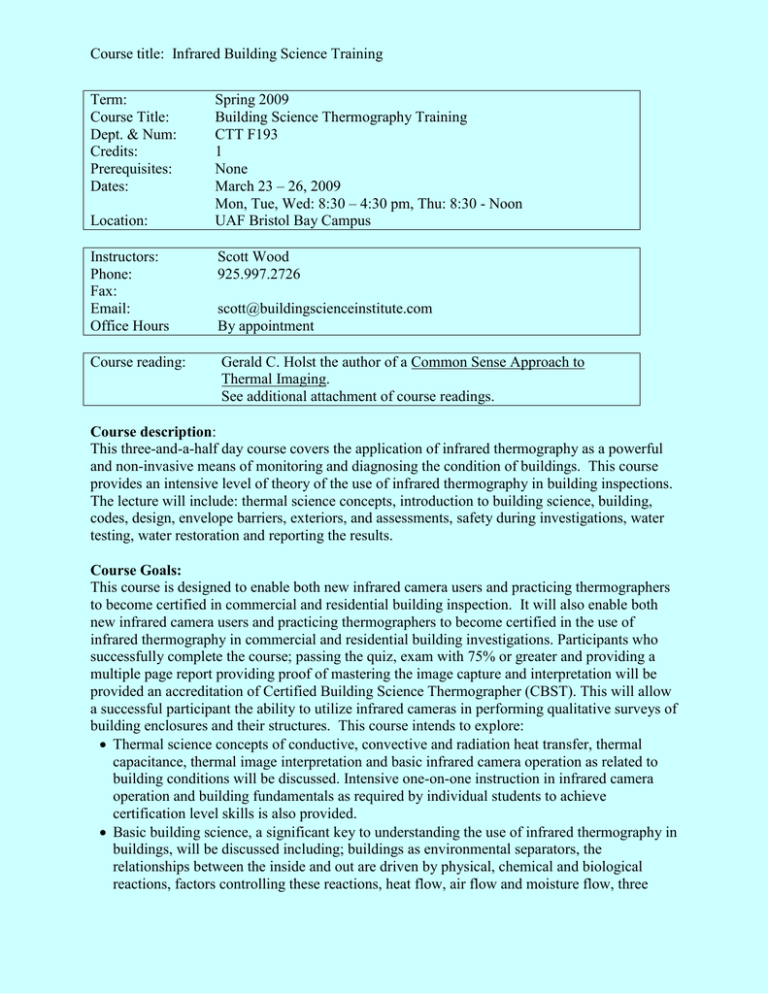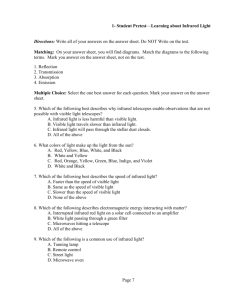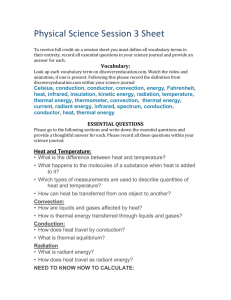2009 syllabus
advertisement

Course title: Infrared Building Science Training Term: Course Title: Dept. & Num: Credits: Prerequisites: Dates: Location: Spring 2009 Building Science Thermography Training CTT F193 1 None March 23 – 26, 2009 Mon, Tue, Wed: 8:30 – 4:30 pm, Thu: 8:30 - Noon UAF Bristol Bay Campus Instructors: Phone: Fax: Email: Office Hours Scott Wood 925.997.2726 Course reading: Gerald C. Holst the author of a Common Sense Approach to Thermal Imaging. See additional attachment of course readings. scott@buildingscienceinstitute.com By appointment Course description: This three-and-a-half day course covers the application of infrared thermography as a powerful and non-invasive means of monitoring and diagnosing the condition of buildings. This course provides an intensive level of theory of the use of infrared thermography in building inspections. The lecture will include: thermal science concepts, introduction to building science, building, codes, design, envelope barriers, exteriors, and assessments, safety during investigations, water testing, water restoration and reporting the results. Course Goals: This course is designed to enable both new infrared camera users and practicing thermographers to become certified in commercial and residential building inspection. It will also enable both new infrared camera users and practicing thermographers to become certified in the use of infrared thermography in commercial and residential building investigations. Participants who successfully complete the course; passing the quiz, exam with 75% or greater and providing a multiple page report providing proof of mastering the image capture and interpretation will be provided an accreditation of Certified Building Science Thermographer (CBST). This will allow a successful participant the ability to utilize infrared cameras in performing qualitative surveys of building enclosures and their structures. This course intends to explore: Thermal science concepts of conductive, convective and radiation heat transfer, thermal capacitance, thermal image interpretation and basic infrared camera operation as related to building conditions will be discussed. Intensive one-on-one instruction in infrared camera operation and building fundamentals as required by individual students to achieve certification level skills is also provided. Basic building science, a significant key to understanding the use of infrared thermography in buildings, will be discussed including; buildings as environmental separators, the relationships between the inside and out are driven by physical, chemical and biological reactions, factors controlling these reactions, heat flow, air flow and moisture flow, three Course title: Infrared Building Science Training damage functions (heat, moisture and UV) and hygric buffer capacities of building components. Building design and construction, principles of heat, air flow and moisture flows, moisture evaluation and control, energy use, electrical problems, and include tips on marketing and selling infrared inspection services. Instructional methods: Lecture and Instructor/Group demonstrations No previous infrared thermography experience is necessary. Some knowledge of basic building construction is helpful, but not required. It is recommended that students bring their own camera for familiarity. Course calendar: Day One Electromagnetic spectrum; what is infrared and how does it compare to other electromagnetic energies. Basic Thermal Science; basic concepts regarding the differences of temperature and energy. Infrared Detection Devices; Specifications including; resolution, thermal sensitivity and limitations for use in building applications. Infrared Camera Functions Introduction; Level, span, range, focus and distance. Basic Heat Transfer; Heat transfer physics, radiation, conduction and convection as they apply to buildings. Determine R-values using actual temperatures. Evaporation and thermal capacities. Take home project: Capture thermal images of an interior located wall (both sides facing the interior of the building) that show as clear s possible any thermal patterns due to conductive differences (studs). Environmental conditions may need to be changed to enhance conductance. Day Two Review images taken for the take home project images. Thermal Image Interpretation; what does the camera see? Image interpretation, StefanBoltzmann Law, Lambert’s Cosine Law, Kirchhoff’s law, effects of surface emissivity on the image captured and temperatures calculated. Qualitative and Quantitative Infrared Thermography; differences between and which is used more in building investigations. Introduction to building science: the study of heat, air and moisture flow, hygric buffer capacity and three important damage functions. Reporting; infrared software available, how to post process captured infrared images. How to report infrared analysis findings with IR reporting software. Work with the programs installed on your computers. Take home project: Determine the temperature of the cold and hot water. Day Three Review images and discussion of the take home project. Course title: Infrared Building Science Training Building Envelope barriers; Heat, Air, Moisture (bulk), Moisture (vapor) (HAMM). Safe Building inspection methods and techniques. Quiz: thermography to building science Building envelopes (concrete, EIFS, Stucco, Wood, Vinyl, Masonry, Roofing); interpreting thermograms of these construction systems. Water Testing; procedures and examples for water testing used for building evaluations. Review for the test Day Four Building Assessments; tying it all together. Water restoration; types of equipment used and drying methods, moisture verification tools and a brief discussion of psychometrics (dew point, RH and AH). Final Test Course policies: Attendance is mandatory; you are expected to attend classes regularly. If an unforeseen circumstance prevents you from attending class you are expected to contact the instructor prior to the start of class. Follow the rules and directions of sponsoring business. UAF requires students to conduct themselves honestly and responsibly, and to respect the rights of others. Late assignments are not accepted without prior approval of instructor. The instructor reserves the right to amend this course outline as needed. Evaluation: Grading Policy: Pass/Fail Activity Points: Lecture/Classroom exercises Attendance Homework Quiz/Final exam Total Grade Rubric: Grade Points P 100-70 F Below 70 5 10 10 75 100 Definition Must receive at least 75% on final exam to receive certification. Student demonstrates independence, show competence and diligence in required work, and lends a hand in mechanical labors without being asked. Demonstrates an understanding of engineering principles and learns how to use appropriate tools and techniques. Student was unable to complete the tasks and assignments on time with at least a 70% understanding and presentation. Course title: Infrared Building Science Training Student Support Services: UAF Bristol Bay Campus Student Services: Mike Swanson, Student Program Development Manager 907-842-5109. Disabilities Services: UAF Disability Services for Distance Students has an office that operates in conjunction with the College of Rural and Community Development (CRCD) campuses and UAF’s Center for Distance Education (CDE). Disability Services, a part of UAF’s Center for Health and Counseling, provides academic accommodations to enrolled students who are identified as being eligible for these services. If you believe you are eligible for these services, visit on the web http://www.uaf.edu/chc/disability.html or contact a student affairs staff person at your nearest local campus. You can also contact Disability Services on the Fairbanks Campus at (907) 4747043, fydso@uaf.edu In Compliance with UAF Faculty Senate Resolution/2004




